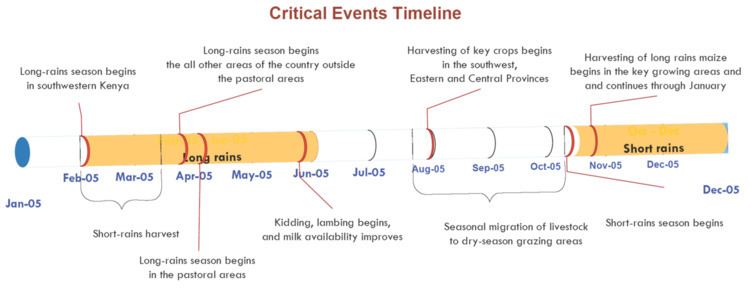Start date 2006 | ||
 | ||
Similar Sahel drought, 2009 Samoa earthqua, 2010 Pakistan floods, Great Famine | ||
In in 2006, an acute shortage of food affected the countries in the Horn of Africa (Somalia, Djibouti and Ethiopia), as well as northeastern Kenya. The United Nations's Food and Agriculture Organization (FAO) estimated on January 6, 2006, that more than 11 million people in these countries may be affected by an impending widespread famine, largely attributed to a severe drought, and exacerbated by military conflicts in the region.
Contents
Causes
Drought is a predictable event in the Horn of Africa, and when combined with other factors it causes conflict and terrible human misery. Previous droughts in 1983–85, 1991–92 and 1998–99 swiftly reversed gradual increase in livestock and caused losses in the cattle population of up to 62%. These conditions of drought, together with other factors including high cereal prices, overpopulation in the region, abandoning traditional rangeland management methods and conflict, are leading to conditions of famine. In the present 2006 drought, claims about factors transforming drought into famine include a ban on livestock imports to markets in the Persian Gulf States, which has reduced the income of livestock-dependent farmers, further increasing food insecurity.
The population in East Africa had increased rapidly in the decades before the food crisis. From 67 million in 1950 to 306 million in 2006. So at least 78% of the people affected by this crisis, were suffering because of the population growth in the previous decades. This means that 78% of this crisis was caused by the population growth since 1950 and the other 22% by the drought. So the amount of people suffering because of the food crisis, was much higher than it would have been without the rapid population growth in the preceding decades. Overpopulation was thus also a contributing factor in this food crisis.
Djibouti
Djibouti was a severely drought affected; the FAO estimated that about one third of the population (400 000 people) needed food aid.
Ethiopia
The FAO estimated that more than one million people in the Somali Region of Ethiopia were facing severe food shortages. Although crops are currently being harvested, shortages are still expected to occur in the country's south-east.
Kenya
Crop failure, drought and depleted livestock herds led to famine conditions in the Cushitic-inhabited northern and eastern pastoral districts of Mandera, Wajir, and Marsabit. As of January 6, 2006, approximately 30 deaths were reported. Some 2.5 million people (10% of the population) required food aid over the next six months, which led the Kenyan President Mwai Kibaki to declare a national disaster.
Somalia
Somalia was the most affected of the four countries. About two million people in the country's southern pastoral regions required humanitarian assistance. The prolonged absence of a strong central government and poor transportation infrastructure also posed problems for the distribution of food aid.
Relief effort
In February 2006, UNICEF warned that 1.5 million children under the age of five were being threatened by the drought and called for $16 million USD to help fund its relief efforts in the region.
